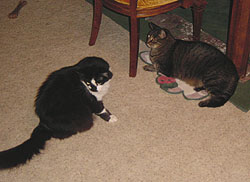|
|
|

Feline Aggression Toward
Cats

Aggression
Toward Kittens
 It
has been observed that occasionally
a male cat will kill young kittens.
This is possible, and usually
occurs in free ranging cats
where a new "Tomcat"
(unneutered male) enters and
takes over an existing group.
Killing the young kittens facilitates
the queen coming into season
again. It has been postulated
(Overall, 1997) that this function ensures male cat certainty
in paternity for kittens
raised on resources in his territory. It
has been observed that occasionally
a male cat will kill young kittens.
This is possible, and usually
occurs in free ranging cats
where a new "Tomcat"
(unneutered male) enters and
takes over an existing group.
Killing the young kittens facilitates
the queen coming into season
again. It has been postulated
(Overall, 1997) that this function ensures male cat certainty
in paternity for kittens
raised on resources in his territory.
 Very
rarely a female will kill her
own young. This is thought to
reflect a poor maternal instinct,
coupled with an abnormally elevated
predatory instinct. If this
occurs, the queen should be
spayed. Very
rarely a female will kill her
own young. This is thought to
reflect a poor maternal instinct,
coupled with an abnormally elevated
predatory instinct. If this
occurs, the queen should be
spayed.
|
In multiple cat households,
cats may fight if resources
are limited. Resources
include food, water,
scratching posts, beds,
litterboxes and human
attention. Up the
resources to lower the
aggression. |
Aggression
Between Adult Cats
 Cats
often fight among themselves
for a variety of reasons including
fighting over territory or a
female in heat. If allowed to
roam, all cats are at much higher
risk for disease and fight injuries
than neutered cats. In some
cases, the cats will never get
along, and must be permanently
separated. However, in most
cases it is recommended to keep
cats 100% indoors, and follow
some simple guidelines to keep
the number of cats down, and
the positive social interaction
up. Cats
often fight among themselves
for a variety of reasons including
fighting over territory or a
female in heat. If allowed to
roam, all cats are at much higher
risk for disease and fight injuries
than neutered cats. In some
cases, the cats will never get
along, and must be permanently
separated. However, in most
cases it is recommended to keep
cats 100% indoors, and follow
some simple guidelines to keep
the number of cats down, and
the positive social interaction
up.
Prevention: Protocol For Introducing A New
Cat Into A Household (See below
for fighting cats.)
-
Introduce the new cat to an enclosed area (e.g. separate
bedroom or bathroom) for 1
- 2 weeks.
- Allow
a minimum of 3 days for the new cat to explore
and gain confidence. A
darkened room that is not in
use is preferred. For some unsocialized fearful animals,
this can take weeks.
-
Feed both (all) cats meals,
on either side of closed doors.
-
Allow cats to hear and
smell each other,
but not see
or touch.
-
Observe body language from
alternate sides of the door.
If either cat is upset, move food back from
the door. Measure the distance
from the door, at which each
cat seems consistently relaxed,
and is ignoring the other.
-
Rotate litterbox and cat bed
to each cat introduce the
new scents. Rub a towel on
each, and let the other sniff
this scent, while praising
and petting
-
Once all cats are eating easily
and relaxed, allow sight but
no contact. E.g. hold door
open 1-2 inches, or feed both
(all) cats in same room, with
new cat in a carrier with
wire front. If the existing
cats hassle the new cat, place
the carrier up on a table,
so the new cat can look down
on the others.
-
When cats can eat near each
other with relaxed body posture,
begin to allow the new cat
out, while other cats are
locked away. Let the new cat
explore and relax in the new
environment.
-
At least initially, provide
one litterbox per cat plus
one extra. Remove unused boxes
after 2 weeks of non-use.
-
Ignore minor squabbles. If
serious fights occur, separate
the cats and follow the protocol
below.
|
Act jolly and relaxed
around the cats to
prevent them from
picking up anxiety,
stress or anger from
you. |
Protocol
To Reduce Fighting Between Housemate
Cats
-
Have both cats fully checked
for minor irritating medical
conditions.
- Neuter
all pets involved in aggression
to remove any hormonal component.
-
If the aggression involves
cats who have lived together
for 1 month or longer, then
isolate the aggressor cat
(lower its status). Do this
even if there are times that
the cats get along fine. Before
any fight, the aggressor cat
typically "stares"
at the other cat, who moves
away.
-
Allow time for the aggressor
to "chill" in
isolation. Try for a darkened
room when not in use to cause
an aggressively aroused cat
to calm down. For some animals
this can take days.
-
Begin feeding cats meals twice
a day, and don't leave
any food down between meals.
-
Feed both cats meals, on either
side of closed door.
-
Once all cats are eating easily
and relaxed, allow sight but
no contact. If body muscle
tone of both cats is relaxed,
proceed to the next step.
-
Confine each in its own wire
front kennel, and place them
several feet apart for dinner.
Now they can see each other
as well as hear and smell,
but still cannot touch. If
they show any tenseness or
twitching, turn the boxes
or move them further away.
If they are relaxed, move
them closer and closer. Tenseness
may vary meal to meal. Just
follow what the tenseness
dictates for that meal.
-
If you can only use one portable
kennel, place it up on a table,
so the new cat can look down
on the former aggressor or
other cats.
-
When
the two target cats are ignoring
each other, allow short periods
where the previously confined
cat has free access to other
cats (e.g. 10 minutes).
-
Dab
a spot of a food flavor on
the cat, for positive association.
Do this just before feeding.
Then feed in same room but
at a distance. Gradually lower
this distance daily, but continue
to separate the cats when
not supervised.
|
Blood work, urinalysis
and fecal exams are
indicated to completely
rule out a physical
irritation before
starting behavior
modification.
|
-
If fights occur during supervision,
shoo away aggressor, then
separate and go more slowly.
Ignore minor squabbles. If
really fighting, isolate and
restart the protocol.
-
If allowed free together and
no sign of aggression, Begin
"cross lap petting."
Two known people sit on a
couch, each with one cat on
their lap. For safety, it
is recommended that each person
have a large towel on their
lap, which they can use to
wrap up a cat who becomes
aggressively aroused. Each
person pets the cat on the
OTHER person's lap,
then back to their own. (Distributing
scent and affection.)
-
At all times, act jolly and
relaxed around the cats so
they don't pick up stress,
anger or anxiety from you.
Praise and give food treats
while acting relaxed and friendly
toward each other.
-
At least initially, provide
one litterbox per cat plus
one extra. Remove unused boxes
after 2 weeks of non-use.
-
Use medication as a last alternative.
The goal is transient use
during behavior modification,
to help make it go smoothly.
One altercation due to
going too fast can set the
entire process back by
weeks. The medication
recommended has few side
effects and does not cause
sedation when dosed properly.
|
|
|